For Decades, "Art" Was An Olympic Sport - Gold, Silver And Bronze Medals Were Awarded At The Games For Painting, Sculpture, Music, Literature And Architecture
The Dutch architect who designed a brick-clad Olympic stadium for the 1928 Games in Amsterdam won an unlikely award: an Olympic gold medal. Alongside athletes competing for gold, silver and bronze medals in gymnastics, diving, and wrestling, Di Stijl designer Jan Wils was awarded first place in the category of architecture. Stranger still: the award was given specifically for his work on the very stadium hosting that year’s Olympic Games.
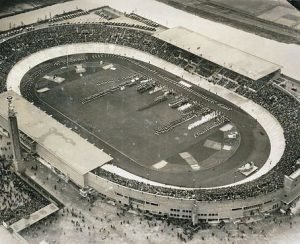 Gold medal-winning Olympic Stadium of the 1928 Games by Jan Wils
Gold medal-winning Olympic Stadium of the 1928 Games by Jan Wils
Jan Wils was not given the only arts award at the event: that same year, dozens of other designers and artists won Olympic medals for everything from town planning to painting. In total, over 1,000 works were submitted in arts categories from 18 countries.
Though many people today have never heard of this art competition component, it was an integral part of the Olympic Games starting in 1908 and its exhibits were paired with sporting events in the Summer Olympics for decades to follow.
 First modern Olympic stadium for the 1896 Games in Athens by VangelisB (CC BY-ND 2.0)
First modern Olympic stadium for the 1896 Games in Athens by VangelisB (CC BY-ND 2.0)
Pierre de Coubertin (short for Pierre de Frédy, Baron de Coubertin) founded the International Olympic Committee (IOC) and played a key role in reviving the Olympic Games as we know them. A historian and educator, his romanticism of ancient Greece led him to become interested in their ancient athletic competitions and the pedagogical potential of sports. In 1896, the IOC oversaw the first full modern iteration of the Olympics, which took place in Athens.
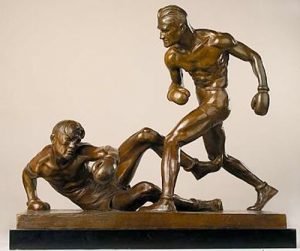 The Knockdown, a gold medal-winning sculpture by Mahonri Young, 1932
The Knockdown, a gold medal-winning sculpture by Mahonri Young, 1932
Coubertin’s vision of the Games, however, was not yet complete; he initially kept a key idea to himself to avoid over-complicating the Games in their first few years. In 1906, he unveiled this idea to the IOC: the Olympic Games should include gold, silver and bronze medals in five categories of the arts: architecture, literature, music, painting and sculpture. Like sports competitors, the artists participating in the new “Pentathlon of the Muses” were supposed to be amateurs.
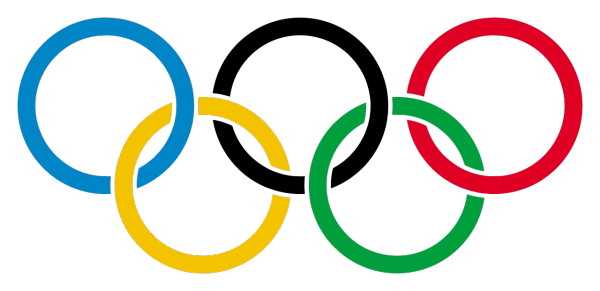 The Olympic Rings logo was designed in 1912 by Pierre de Coubertin to encompass the six colors (five rings plus the white background) found in the flags of all participating countries
The Olympic Rings logo was designed in 1912 by Pierre de Coubertin to encompass the six colors (five rings plus the white background) found in the flags of all participating countries
His notion was not as strange as it might sound at first. After all, some ancient versions of the Games included awards for music, singing and heralding (public announcement). As Coubertin wrote at the time, advocating this addition: “In the high times of Olympia, the fine arts were combined harmoniously with the Olympic Games to create their glory. This is to become reality once again.”
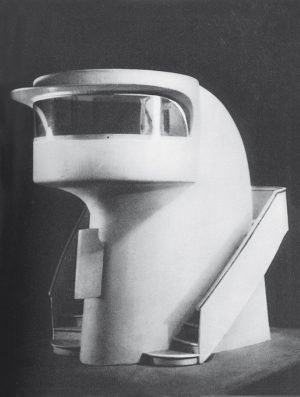 Timekeeping pavilion by Guglielmo Giuliano, submitted to the 1936 Berlin Olympics
Timekeeping pavilion by Guglielmo Giuliano, submitted to the 1936 Berlin Olympics
In the modern Olympics, the entries were supposed to be original works inspired by sports. For architects, this led to submissions including athletic stadiums, sporting complexes, playing fields, swimming pools and even ski jumps. In most cases, artists were required to submit works that had not been previously published, exhibited or performed. Exceptions were made for the category of architecture, where conceptual designs were considered alongside built works.
The arts competitions were originally supposed be part of the 1908 Olympics in Rome, Italy, but fell through when the event was moved to London, England. The IOC managed to get them included in the 1912 Games in Stockholm, Sweden. At first, the arts entries were more of a sideshow, with only a few dozen submissions and handful of awards, but they gained momentum in the decades to come.
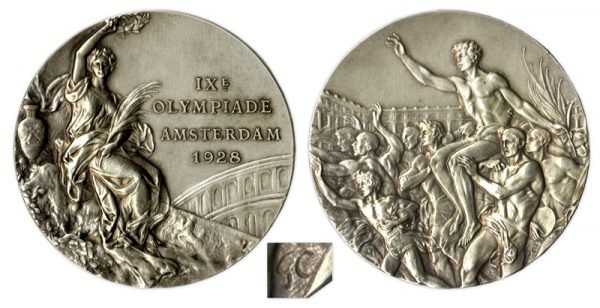 Olympic gold medal designed by Giuseppe Cassioli for the 1928 Games via Nate D. Sanders
Olympic gold medal designed by Giuseppe Cassioli for the 1928 Games via Nate D. Sanders
Starting in the 1920s, as the arts component of the Games continued to grow, the organizers began to subdivide the original five categories :
- “architecture” added “town planning”
- “painting” added “drawing” and “graphic works”
- “sculpture” split into “statues” and “reliefs and medallions”
- “music” split into “song,” “orchestra” and “single instrument”
- “literature” split into “lyric works,” “epic works” and “dramatic works”
By the 1940s, the arts events were hugely popular, drawing big crowds to exhibitions set up alongside the sports competitions. Some artists were even selling their award-contending works during the Games.
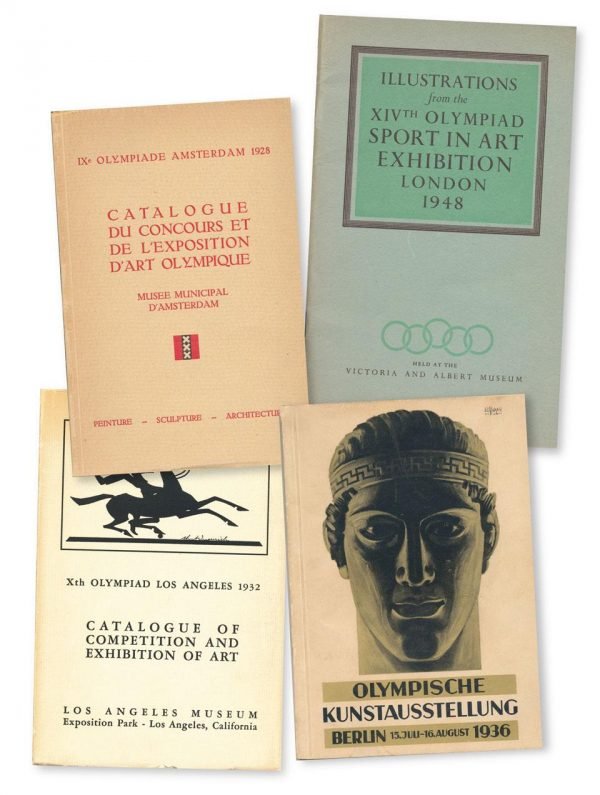 Pamphlets for art competitions and exhibitions from 1928 to 1948 via domus
Pamphlets for art competitions and exhibitions from 1928 to 1948 via domus
The IOC, however, was growing concerned: the Olympics were supposed to be for amateurs, yet most of the arts participants were professionals. Partly on that basis, the IOC decided to discontinue the arts awards after the London Games of 1948. Some attempts were made in the following years to restart the arts awards or include an official but non-competitive exhibition.
After a long series of debates within the IOC, it was eventually decided that the Summer Olympics would facilitate arts festivals in future iterations. Today’s Olympic charter still insists on “a programme of cultural events which must cover at least the entire period during which the Olympic Village is open,” hence the Cultural Olympiad.
Notable Olympic Arts Medalists
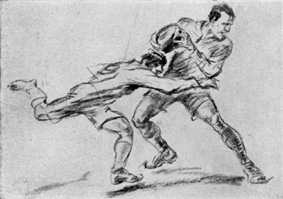 Rugby drawing by Jean Jacoby, the only person to win two gold medals in the arts
Rugby drawing by Jean Jacoby, the only person to win two gold medals in the arts
With the IOC only officially maintaining records for sports winners and not the arts, most of the contenders in Olympic arts competitions have largely since disappeared from history. Many were indeed amateurs and few went on to become famous. Over the few decades of the competitive arts events, however, some strange records were set, including a handful that may never be broken (such as: winning medals both in Olympic arts and sports competitions):
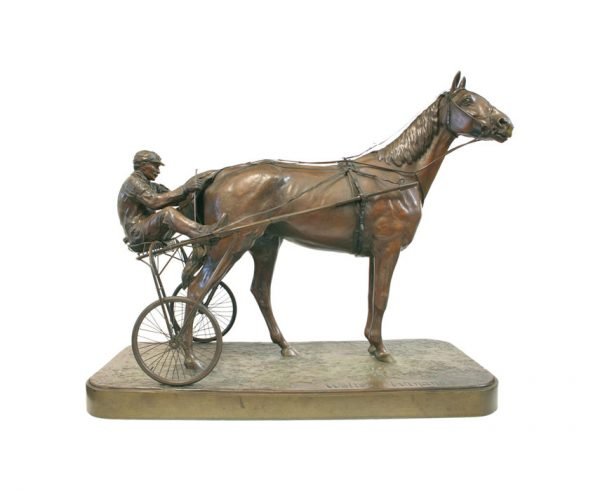 An American Trotter, medal-winning statue by Walter W. Winans
An American Trotter, medal-winning statue by Walter W. Winans
- Walter W. Winans of the United States received medals for marksmanship at the 1908 and 1912 Olympics; in the latter Games, he also won a gold medal for his sculpture An American Trotter.
- Alfréd Hajós, a Hungarian architecture student, won two gold medals for swimming at the 1896 Olympics; 28 years later he was awarded a silver medal in architecture for a stadium he co-designed.
- John Copley of Great Britain became (and as yet remains) the oldest Olympic medal winner, thanks to a silver he received for an etching at the 1948 Games; he was 73 years old at the time.
- Pierre Coubertin, the IOC founder himself, also won an Olympic arts medal in 1912 for a rather dull piece of poetry called Ode to Sport, submitted under a pair of pseudonyms. Indeed, his was the first gold medal in literature. Perhaps, knowing his own athletic limitations, this was his secret hope all along … his one chance to go for the gold:
“O Sport, pleasure of the Gods, essence of life, you appeared suddenly in the midst of the grey clearing which writhes with the drudgery of modern existence, like the radiant messenger of a past age, when mankind still smiled. And the glimmer of dawn lit up the mountain tops and flecks of light dotted the ground in the gloomy forests.”
Further winners for each arts event can be explored by year as follows: Stockholm, Sweden in 1912; Antwerp, Belgium in 1920; Paris, France in 1924; Amsterdam, Netherlands in 1928; Los Angeles, United States in 1932; Berlin, Germany in 1936; and London, England in 1948.
Architects Still Going for the Gold
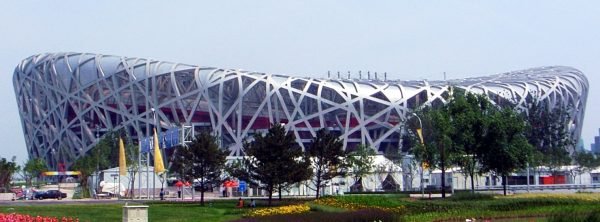 The 2008 Beijing National Stadium, dubbed “The Bird’s Nest,” designed by Herzog & de Meuron (image by Chen Zhao (CC BY 2.0). The 2008 Olympic Village in Beijing was certified LEED Gold.
The 2008 Beijing National Stadium, dubbed “The Bird’s Nest,” designed by Herzog & de Meuron (image by Chen Zhao (CC BY 2.0). The 2008 Olympic Village in Beijing was certified LEED Gold.
Today, architectural competitions and awards are alive and well outside of the Olympic Games. Gold medals are still given out, but through programs like Leadership in Energy and Environmental Design (or: LEED), which certifies buildings for sustainability. The American Institute of Architects (AKA the AIA) has been awarding gold medals since 1907, the year after Coubertin first pitched his idea to the IOC.
Definitely think art should be reintroduced to the Olympics. That would be epic.
Interesting article. But it's plagiarized. Next time give credit to the original authors or better yet, create your own interesting content or add some interesting commentary to your article.
Timekeeping pavilion by Guglielmo Giuliano. So awesome!